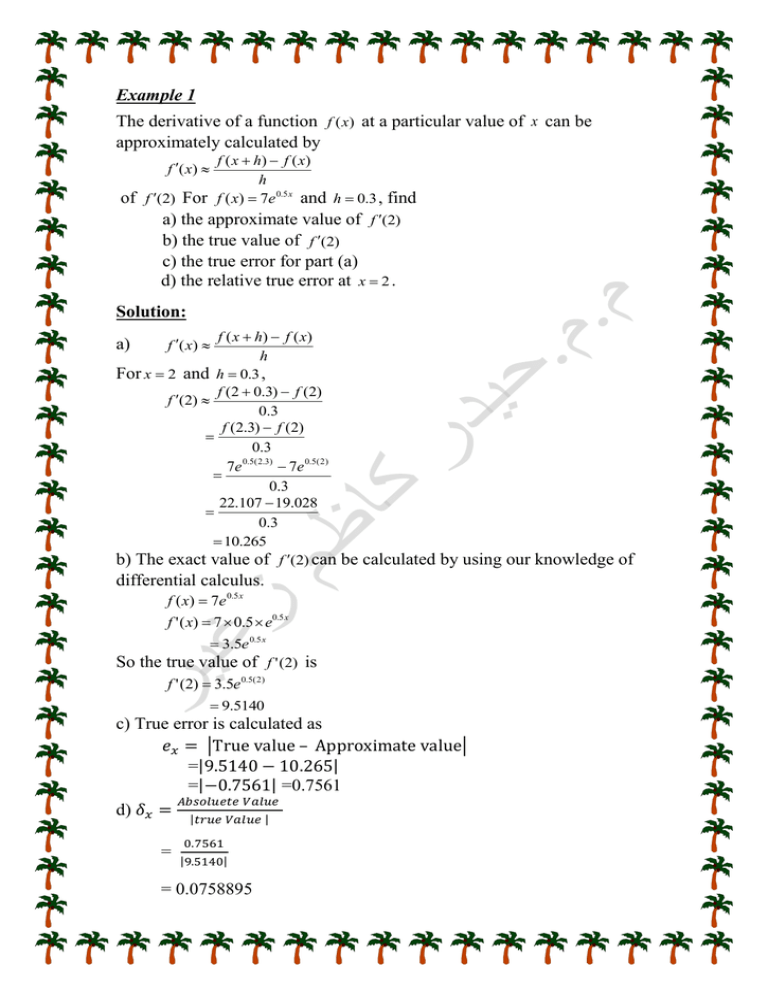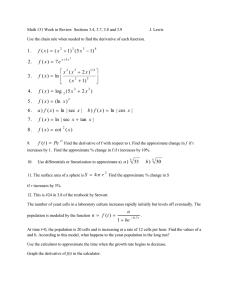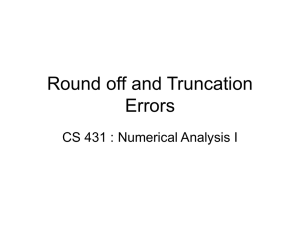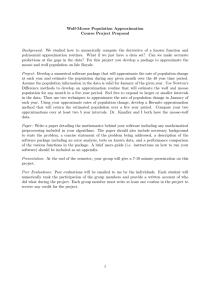Example 1 The derivative of a function at a particular value of
advertisement

Example 1 The derivative of a function f (x) at a particular value of x can be approximately calculated by f ( x h) f ( x ) h of f (2) For f ( x) 7e 0.5 x and h 0.3 , find a) the approximate value of f (2) f ( x) b) the true value of f (2) c) the true error for part (a) d) the relative true error at x 2 . Solution: f ( x h) f ( x ) h For x 2 and h 0.3 , f (2 0.3) f (2) f (2) 0.3 f (2.3) f (2) 0.3 0.5( 2.3) 7e 7e 0.5( 2) 0.3 22.107 19.028 0.3 10.265 b) The exact value of f (2) can be calculated by using our knowledge of a) f ( x) differential calculus. f ( x) 7e 0.5 x f ' ( x) 7 0.5 e0.5 x 3.5e 0.5 x So the true value of f ' (2) is f ' (2) 3.5e 0.5( 2) 9.5140 c) True error is calculated as – | | =| | =0.7561 =| d) | | = | | = 0.0758895 | = 7.58895% 8 – Approximate Error:is denoted by and is defined as the difference between the present approximation and previous approximation. Approximate Error= | – | Relative approximate error:is denoted by and is defined as the ratio between the approximate error and the present approximation. Relative approximate error | | Example 3 The derivative of a function f (x) at a particular value of x can be approximately calculated by f ( x h) f ( x ) h 0.5 x For f ( x) 7e and at x 2 , find the following a) f (2) using h 0.3 f ' ( x) b) f (2) using h 0.15 c) approximate error for the value of f (2) for part (b) d) the relative approximate error Solution: a) The approximate expression for the derivative of a function is f ( x h) f ( x ) . h For x 2 and h 0.3 , f (2 0.3) f (2) f ' (2) 0.3 f (2.3) f (2) 0.3 0.5( 2.3) 7e 7e 0.5( 2) 0.3 22.107 19.028 0.3 10.265 f ' ( x) b) Repeat the procedure of part (a) with h 0.15, f ( x h) f ( x ) h For x 2 and h 0.15 , f ( x) f (2 0.15) f (2) 0.15 f (2.15) f (2) 0.15 0.5 ( 2.15) 7e 7e 0.5( 2) 0.15 20.50 19.028 0.15 9.8799 c) So the approximate error , E a is f ' (2) Ea | – | | = | | =0.38474 =| d) Relative approximate error | | | | = 0.038942*100% = 3.8942% Q/ While solving a mathematical model using numerical methods, how can we use relative approximate errors to minimize the error? A: In a numerical method that uses iterative methods, a user can calculate relative approximate error at the end of each iteration. The user may pre-specify a minimum acceptable tolerance called the pre-specified tolerance . If the absolute relative approximate error is less than or equal to the pre-specified tolerance that is, , then the acceptable error has been reached and no more iterations would be required . Alternatively, one may pre-specify how many significant digits they would like to be correct in their answer. In that case, if one wants at least m significant digits to be correct in the answer, then you would need to have the absolute relative approximate error. Example 5 If one chooses 6 terms of the Maclourin series for e x to calculate e 0.7 , how many significant digits can you trust in the solution? Find your answer without knowing or using the exact answer. Solution ex 1 x x2 ................. 2! Using 6 terms, we get the current approximation as e 0.7 0.7 2 0.7 3 0.7 4 0.7 5 1 0.7 2! 3! 4! 5! 2.0136 Using 5 terms, we get the previous approximation as e 0.7 1 0.7 0.7 2 0.7 3 0.7 4 2! 3! 4! 2.0122 The percentage absolute relative approximate error is | | = | | Since answer of , at least 2 significant digits are correct in the e 0.7 2.0136 Example 6:Find the Taylor Series expansion for at Sol: ( ) ( ) ( ) ( ( ) ( ) ) ( ) ( ) Can using form alternative for Taylor series now ( ) ( ) Example7 Find the value of f 6 given that f 4 125 , f 4 74 , f 4 30 , f 4 6 and all other higher derivatives of f x at x 4 are zero. Solution since fourth and higher derivative of ( ) are zero at x 4


